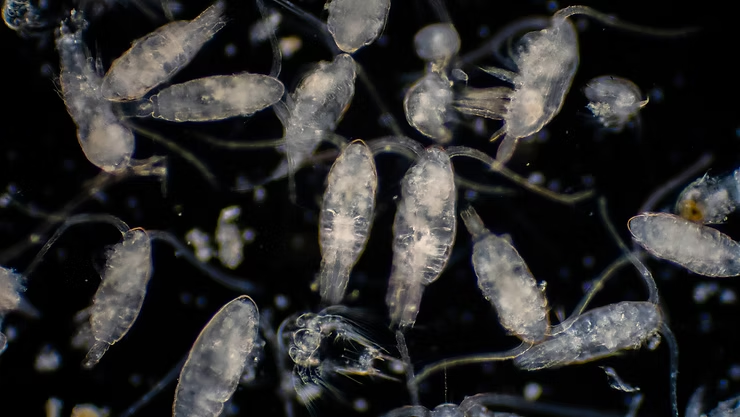Introduction to Zooplankton
Zooplankton may be small, but their role in marine ecosystems is immense. These drifting organisms, ranging from microscopic protozoa to larval stages of larger animals, form a critical link in the oceanic food web. By feeding on phytoplankton and serving as prey for larger marine species, they help sustain the balance of life beneath the waves.
What Are Zooplankton?
Zooplankton are organisms that drift with ocean currents rather than swimming against them. They include:
- Protozoa: Single-celled organisms that form the base of the food chain.
- Larvae: Early life stages of crabs, starfish, and jellyfish.
- Small Crustaceans: Copepods and cladocerans that dominate many marine environments.
Though often invisible to the naked eye, their collective presence drives productivity across the oceans.
Types of Zooplankton
- Holoplankton: Permanent plankton such as copepods that spend their entire lives drifting.
- Meroplankton: Temporary plankton like crab or starfish larvae that eventually grow into bottom-dwelling adults.
This diversity allows zooplankton to fill multiple ecological niches, from grazers of phytoplankton to prey for predators higher in the chain.
Importance in the Ecosystem
Zooplankton are indispensable to marine ecosystems. Their significance includes:
- Recycling nutrients that support phytoplankton growth.
- Controlling bacterial and algal populations through grazing.
- Mixing ocean layers during migration, influencing nutrient and oxygen distribution.
- Acting as environmental indicators for ocean health and climate change.
Without zooplankton, entire marine food webs would collapse, affecting fish stocks, seabirds, and even human economies.
Feeding Habits
These tiny drifters employ diverse feeding strategies:
- Filter Feeders: Species like cladocerans strain water for phytoplankton.
- Predators: Some copepods actively hunt smaller organisms.
- Detritivores: Certain zooplankton feed on organic debris, recycling nutrients back into the system.
This flexibility ensures their survival in a wide range of environments.
Reproduction
Zooplankton reproduce through different strategies:
- Sexual Reproduction: The most common method, involving eggs and sperm.
- Parthenogenesis: Asexual reproduction in which females produce offspring without fertilization.
These strategies allow them to adapt quickly to environmental pressures and maintain populations even under stress.
Migration Patterns
Zooplankton migration is one of the largest daily movements of biomass on Earth. Common patterns include:
- Vertical Migration: Descending during the day to avoid predators and rising at night to feed.
- Horizontal Migration: Moving with currents or toward nutrient-rich waters.
- Seasonal Migration: Adjustments based on temperature and food availability.
These migrations not only enhance survival but also influence ocean nutrient cycles and energy transfer.
Conclusion
Zooplankton may be microscopic, but they play a massive role in maintaining the balance of marine ecosystems. Their feeding, reproduction, and migration ensure that energy flows seamlessly from the smallest producers to the largest predators. By studying and protecting zooplankton, we safeguard the very foundation of ocean life.
Frequently Asked Questions
What role do zooplankton play in marine ecosystems?
They form the base of food chains, feeding larger species like fish and whales.
How do zooplankton reproduce?
Most reproduce sexually, while some can reproduce asexually through parthenogenesis.
What are the main types of zooplankton?
Holoplankton, which remain plankton for life, and meroplankton, which spend only part of their lifecycle as plankton.
Do zooplankton migrate?
Yes, most exhibit vertical migration, rising at night to feed and descending during the day.
Why are zooplankton important in the carbon cycle?
They transfer carbon by consuming phytoplankton and exporting it to deeper waters through waste and sinking bodies.

